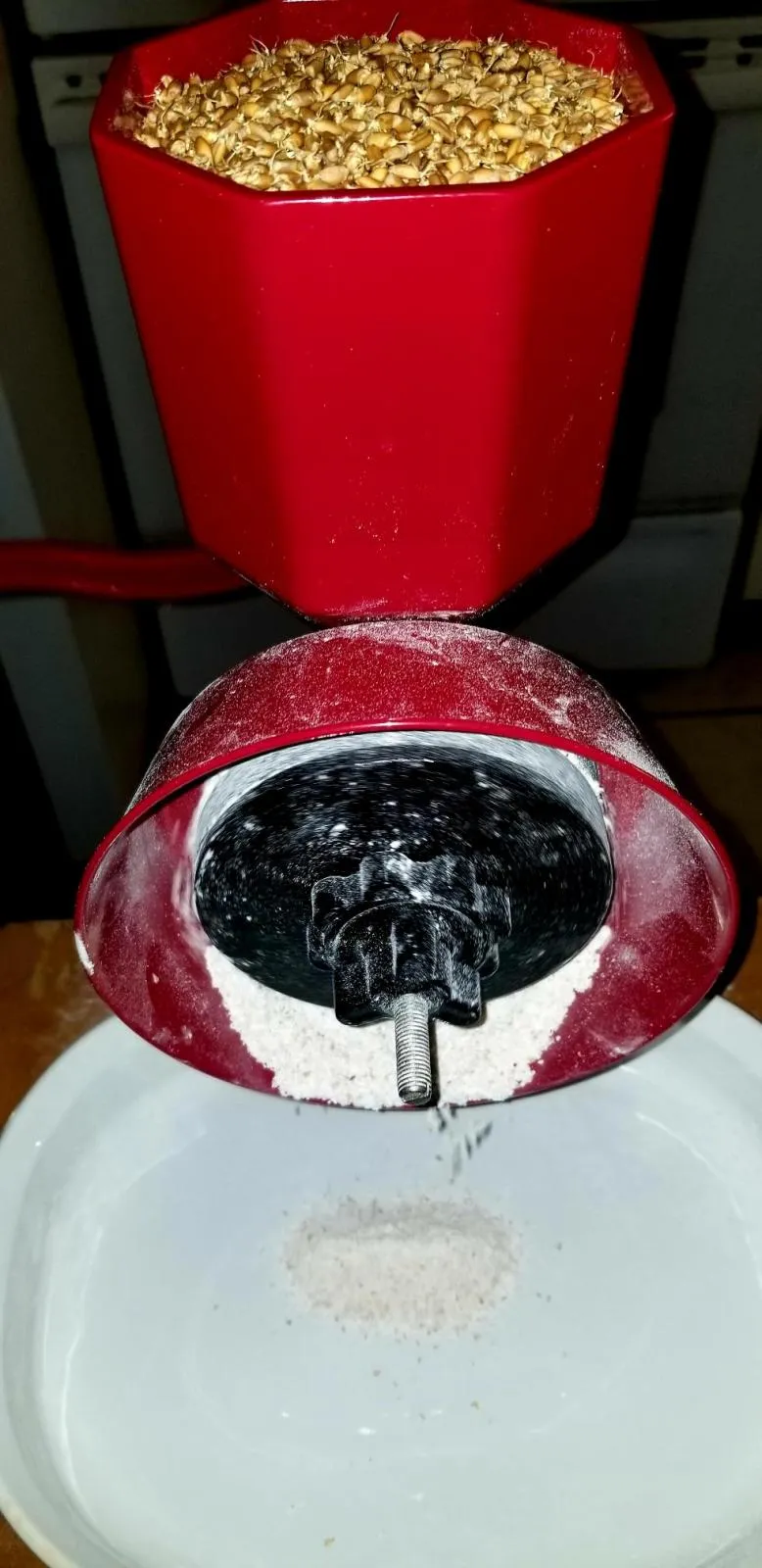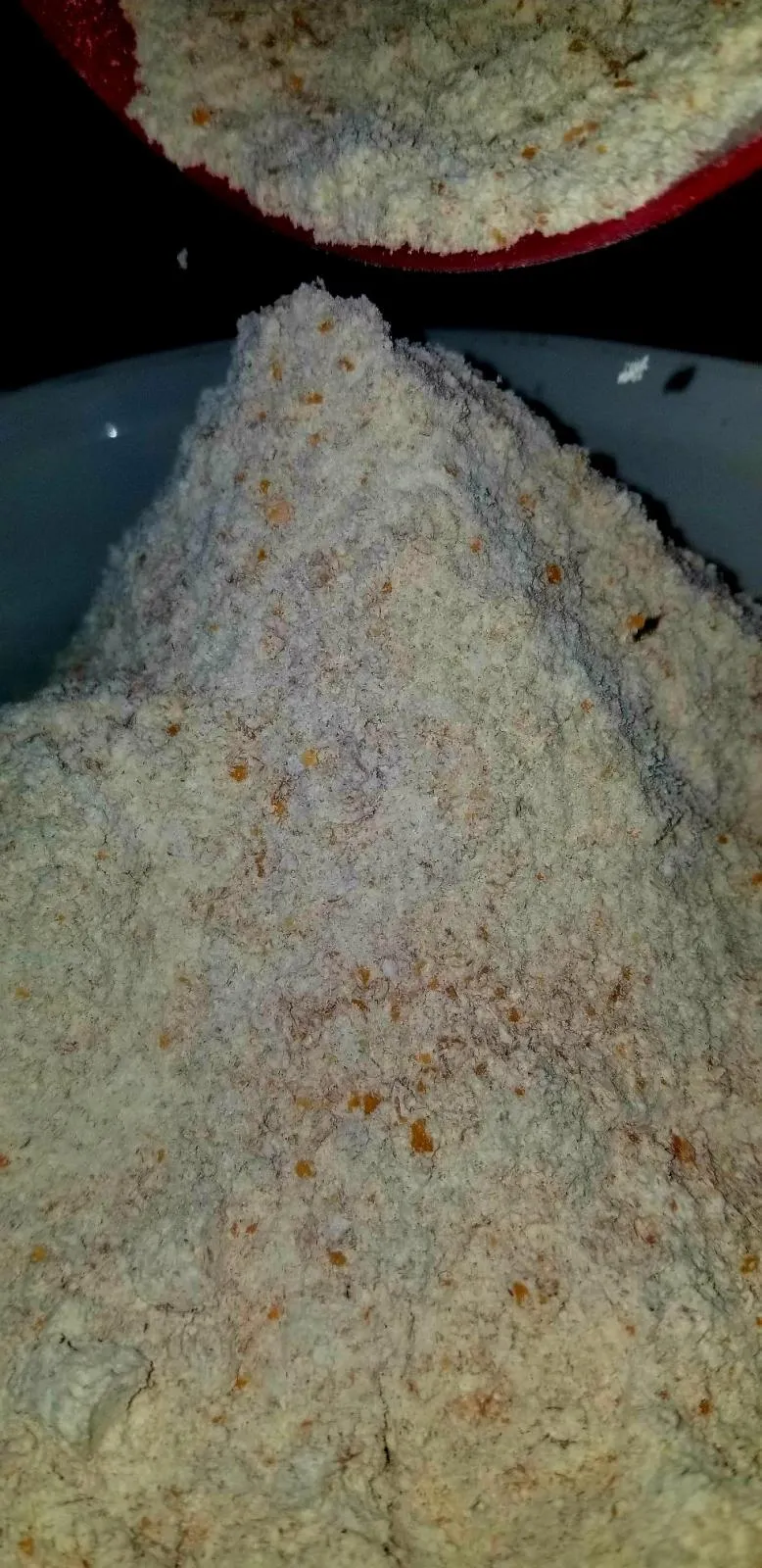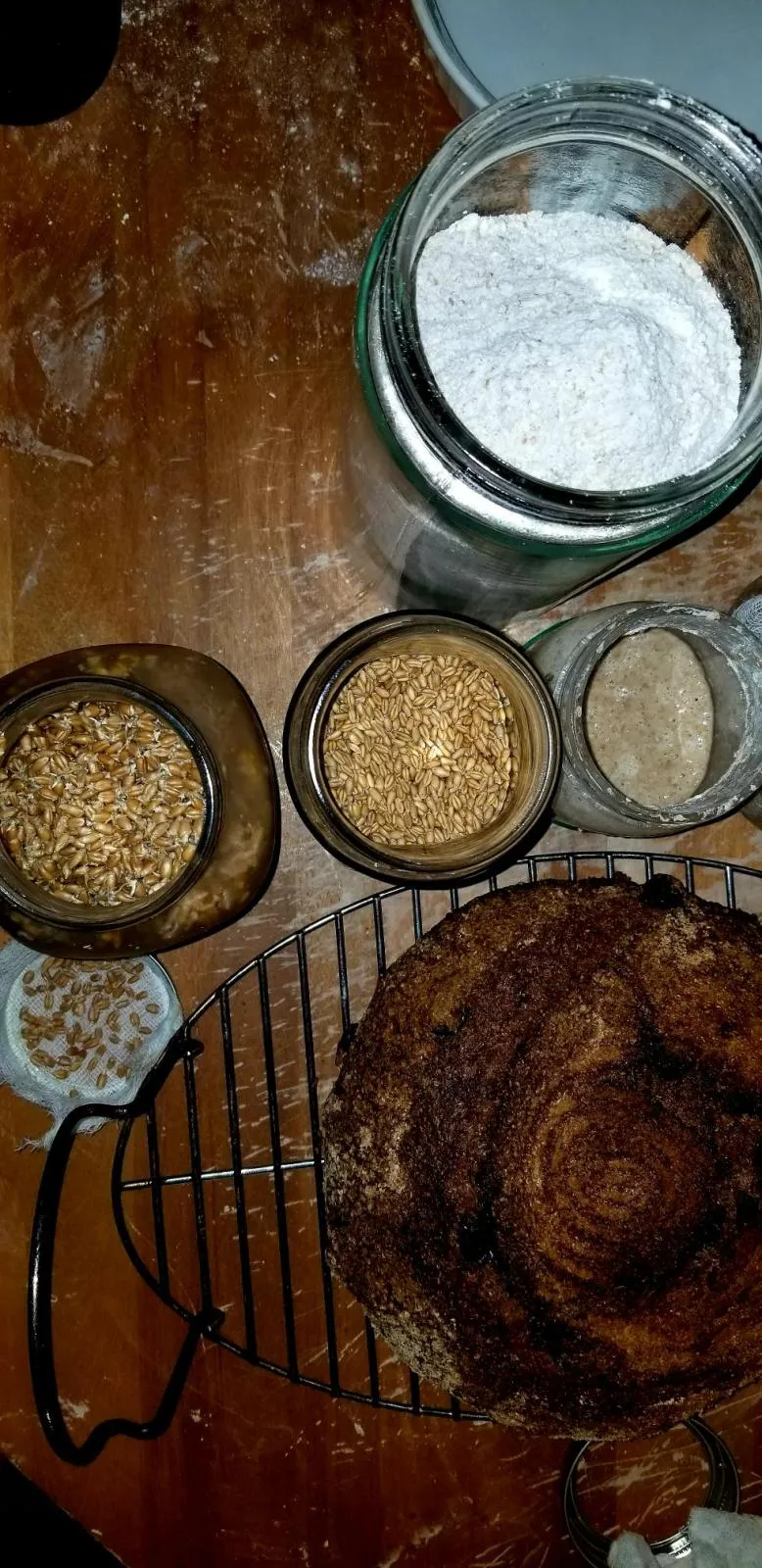Hello,
I want to make a malt loat from Bertinet's book Crumb. It requires malt wheat flour and I was wondering if this link that I found is it:
Giusto's Vita-Grain All-Natural Artisan Malted Unbleached Bread Flour, 5lb Bag https://www.amazon.com/dp/B08HSPX7LM/ref=cm_sw_r_apan_i_2PPX3XYDMT8NY89C36Z4?_encoding=UTF8&psc=1
Anyhow finding lots of malted barley options but not malted wheat.
Apologies if this is a stupid question... Kinda new to this.
Thanks in advance!
It's not the same.
It's still bread flour...heavily processed commercial flour...the important parts of the wheatberry containing the nutrients (and flavor) have been removed. Which makes me very curious about how that product could be produced. Are the berries sprouted first and then they remove the bran and germ and mill the endosperm? It's a contradiction. It's a farce and just another label, another way to make money is how I see it.
I suppose if you must purchase it ready-made, look for one that has absolutely no ingredients except for one, that is, sprouted wheat. I still wonder about this because flour oxidizes and goes rancid sooner than one may think. But it's definitely still better than a product with an extensive ingredient list.
Malted wheat flour is simply flour that was made from sprouted wheat.
I do this myself at home. I purchase local organic wheatberries, soak for 12 hours, drain, put them in jars, filling them up no more than half way, so that there is aeration and oxygen and no possibility of mold growth. I keep the wheatberries moist, rinsing 1-3 times daily as necessary, and keep them in the dark, and that encourages germination. I place the jars upside down using a cheesecloth and rubber band for the excess moisture to drain. It will sprout after a couple days. Then airdry them over another couple days, then mill.
Image

Image

Image

Thanks for your reply! I bet I can actually do all that myself if I had time. But I think I found this ready made!
https://www.vitacost.com/one-degree-organic-foods-organic-sprouted-whole-wheat-flour-32-oz?
Anyhow probably not as good as whta you make... But will fit my schedule.
Thank you!
You're very welcome! That new link looks excellent, that's what I would buy if I were unable to prep my own. Great find.
Yes, I figured as much. I'm on Disability, and I'm isolated, so yeah, if there's anything I've got, it's a ton of time.
I just meant to provide some background information. This was all news to me until recently.
Malted flour in the UK is a specialty bread flour with at least 4% of malted barley flour in it. Sometimes chopped or flaked malted grains or seeds are added to it as well, for taste and texture, for crunch. It has malty taste and aroma and can be tan colored if malt was dark, roasted prior to milling it. The malt used is non diastatic, heated, inactivated, so you can substitute dark barley malt syrup if you wish, the resulting bread would be the same. Such malted bread is very popular in the UK and Ireland.
Examples of specialty malted flours and barley malt flours and chops of different darkness to create your own malted flour mixes
https://www.bakerybits.co.uk/flour/flour-by-style/malted
What you linked is malted in a different sense. It has 0.2-0.5% of diastatic barley malt added. Not for the aroma or malty taste of bread, but for fermentation, as a source of alpha amylase in flour. Nearly all bread flour and all purpose flour in the world is malted in this way, although modern millers and bakers prefer to add amylase directly
Bertinet's loaf has plain bread flour, malted wheat flakes and malted wheat flour in it, meaning (non diastatic) wheat malt milled into flour and rolled into flakes, both. Wheat malt is sold in beermaking supplies stores for about $2-3 per pound. For example
Thank you!
So for the bread... Do you recommend using regular bread flour instead of malted wheat and adding white wheat malt(assuming I have to grind it) into the dough or adding dark barley malt syrup into the dough?
In either case what perportion do you recommend? I. E. If a recipe calls for 100g of malted wheat flour how much syrup or white wheat malt do I add?
Thanks again... This really clears things up!
Yes. Bertinet's recipe for Malted Wheat Sourdough lists
strong white bread flour;
rye flour;
malted wheat flakes;
malted wheat flour
dark malt beer; malted dark ale
IN the US, regular bread flour IS strong bread flour, so use regular bread flour.
Where it says malted wheat flour, you would have to purchase wheat malt from beermaking supply store, roast it a bit on a skillet or in a microwave, just to heat it through, and mill 100g of wheat malt into flour in your coffee grinder or blender/food processor.
Alternatively, you could substitute
100g of malted wheat flour = 100g bread flour +130g of barley malt syrup.
I.e. instead of adding milled wheat malt, add regular wheat flour + malt syrup. Reduce water in the bread dough a little bit afterwards to compensate for the syrup.
Sweet! Will do!
Also I have a place to get malted wheat flakes. So now I can make this!
Thanks!
Hi Mariana,
Thanks for the information on the forms that malt (syrup, powder and flour) comes in!!
In the last 3 flas bakes (100% whole wheat lean dough) I used 5% freshly milled malted wheat from the beer brewer store- the rest was 95% freshly milled red wheat berries.
It added a significant feature to the pita (made on the stovetop) when it was toasted later - a light crunch , separately felt, on the skin of the pita and a very soft chewy interior. I have made hundreds of ww pita ( as with a simple rye sour, flas, clas, or other sourdoughs) that did not have any of the malt flour (freshly ground) and these former pita did not show this characteristic. There was a ME restaurant in Crystal City (near DC) many years ago that had this feature on their naan and pita which I have always wanted to get. Would there be a reason?
The same dough when baked as a loaf in the zoji was also very different from former loaves: Even though the zoji bakes at very low temps compared to an oven bake, the crumb was tender, chewy and had a much better profile (bubbles, less dense at the bottom too). I let it go to 209F final DT in the zoji .
Because of these last 3 doughs all showing a marked improvement in the end product, I am tempted to think it has to do with the malted flour.
What do you think?
Hi Joe,
I must say that I love your breads, your baking. They are great!
5% malt is a very bold number, very risky. It makes wheat crumb very creamy to bite, custardy. I actuaILy like it and some bakers love it, such as Tartine bread's creator Chad Robertson, he loves creamy-custardy crumb in his breads. And yes, it lowers gluten% significantly, making toasted crust delightfully crunchy, almost like biting a crispy cookie. Your powers of observation are so great, I am so proud of you! 👏👏👏
Scalding a portion of the flour in the recipe achieves similar effect, i.e. tangzhong method and its variations.
i usually stick to 2% malt for bread flours and white rye flour and add 5% malt only to dark rye flours with very high falling numbers.
Hi Mariana,
You know the reason I used malt grains? I had bought 4 lbs of wheat malt from the beer hobbyist shop and thought I might need to use it up since I was preferring the rye malt for clas and flas! I didn't know it was risky!!
3 things got me to this loaf: all the recent posts on malt flour (most of which was way over my head), Yippee's pointers on how to mix (30 min in 3 phases in zoji) and ferment clas loaves (recipe-Simple 100% ww with Clas) and your remark once that you routinely baked bread in the zoji.
It was some stumble into this nice chewy and toasty loaf!
Are labs holding back some of the degradation effects of the malt? what are high falling numbers?
Thank you for the mountain of "nuggets" that you are giving us all the time!!
Hi Joe, it is good that you are learning as you are baking, not just reading. That is probably the only way to truly great bread. And Zoji is the best helper, with it you learn 4 times faster, because it allows you to have up to four test bakes per day, adjusting parameters one at a time, seeking perfection : )
It depends on time and the amount of lactic acid starter used (versus that specific malt% of course). Microorganisms do not become immediately active let alone achieve their peak active state in a new environment, they first take their time to adapt to it.
It is called a lag phase and lasts for about an hour (30-120min depending on the severity of change and on specific microorganisms). With CLAS and FLAS bulk fermentation and proof are so short that sometimes they take less than an hour together. LABs never become truly active before they perish in the oven.
So, when you add lactic acid starter to your bread dough, unless you add a lot of it while using modest amounts of diastatic malt, it will not suppress enzymatic activity that much. With time, LABs will adjust to the environment inside the bread dough and will produce acids and slow down enzymatic action significantly thus protecting your bread from having that dreaded sticky gummy crumb which looks almost normal when cut but feels like glue on your teeth when bitten.
mariana,
Do you know of a North American source of non-diastatic malted wheat products like those sold by BakeryBits? The overseas shipping from BB is prohibitive.
I know King Arthur has the malted wheat flakes, but the price with shipping is also expensive ($13/lb). KA also does not sell the Nuttimalt nor any of the malt flours that are sold by BB.
As you mentioned, I can purchase inexpensive diastatic wheat malt at a brew store but flaked malt is not available; only unmalted flaked wheat. This flaked wheat does not impart the texture that the thicker malted wheat flakes do. I found it blends into the final crumb of the bread.
I would like to approximate the malt flours that BB sells, but I did not get a satisfactory answer from BB on the color of the flours compared to brewing malt. Do you have any thoughts on which barley malts would be most appropriate?
How much does diastatic wheat malt need to be heated to render it non-diastatic? You mentioned heating in a microwave or roasting on the stove. Does it need to change color to deactivate the amylase?
Thanks!
alcophile,
no, I get them from BakeryBits.
The origin or the nature of 'flakes' is not that important, they can be malted or unmalted, wheat, rye, barley, rice, or oats, for as long as you utilize the trick I explained above:
100g malted flakes = 100g regular flakes + 130g liquid malt extract (or dry malt extract+water).
Liquid malt extracts come in a variety of colors and origins, wheat malt extract, rye malt extract, barley malt extract, rice malt syrup, colorless, extralight or pale, medium, extra dark, etc. The same is with DMEs. Dry malt extracts, they come in a range of colors, from pale to very dark. So you can mix and match as your heart desires for a variety of textures, colors and aromas/tastes/flavors.
LMEs and DMEs are always non-diastatic, as are flaked kernels of common grains sold everywhere (wheat flakes, rolled oats, rye flakes, barley flakes, rice flakes, etc). Examples.
Malted wheat flakes and other soft grain flakes (white wheat flakes, precooked rye flakes, fast cooking rolled oats, etc.) will dissolve in the crumb, for sure. Hard Red wheat flakes, regular rye flakes - not so much, especially if you add them as raisins, after kneading your dough. Many mills come with a flaker attachment, you can make your own, set the desired thickness. I prefer to use flakes/rolled oats externally, they shine that way, and chops and cracked grains in the dough, as in my favorite - Cracked Wheat Bread.
No dark roasting is necessary to deactivate enzymes. Roasting/caramelizing is for flavor. Simply heating them (whole malt or chops or flakes) through is enough. We had a discussion about milk not long ago here on TFL, how to deactivate milk enzymes, and the scientific data shows that about 10 min at 90-95C would be enough to deactivate enzymes fully and irreversibly.
best wishes,
m.